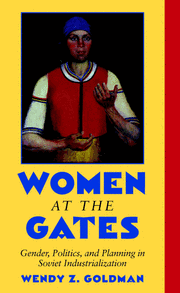Book contents
- Frontmatter
- Contents
- Acknowledgments
- List of Illustrations
- List of Tables
- Acronyms and Abbreviations
- Women at the Gates
- Introduction
- 1 Guarding the Gates to the Working Class: Women in Industry, 1917–1929
- 2 The Struggle over Working-Class Feminism
- 3 The Gates Come Tumbling Down
- 4 From Exclusion to Recruitment
- 5 “The Five-Year Plan for Women”: Planning Above, Counterplanning Below
- 6 Planning and Chaos: The Struggle for Control
- 7 Gender Relations in Industry: Voices from the Point of Production
- 8 Rebuilding the Gates to the Working Class
- Conclusion
- Index
- Plate Section
8 - Rebuilding the Gates to the Working Class
Published online by Cambridge University Press: 30 July 2009
- Frontmatter
- Contents
- Acknowledgments
- List of Illustrations
- List of Tables
- Acronyms and Abbreviations
- Women at the Gates
- Introduction
- 1 Guarding the Gates to the Working Class: Women in Industry, 1917–1929
- 2 The Struggle over Working-Class Feminism
- 3 The Gates Come Tumbling Down
- 4 From Exclusion to Recruitment
- 5 “The Five-Year Plan for Women”: Planning Above, Counterplanning Below
- 6 Planning and Chaos: The Struggle for Control
- 7 Gender Relations in Industry: Voices from the Point of Production
- 8 Rebuilding the Gates to the Working Class
- Conclusion
- Index
- Plate Section
Summary
The creation of a new communist state demands from all participants in socialist construction a firm, genuinely proletarian labor discipline, the fullest use of every working day, every working hour, and the decisive elimination of all types of disorganized production, in particular absenteeism.
Trud, labor newspaper, 1932Why do we need a second five-year plan when we have not gotten anything from the first one?
Worker in a mechanical factory in Briansk, 1932Purge the Towns of Social [i.e., Human] Garbage!
Headline in Trud, 1932By the end of the term of the first five-year plan, 10.7 million new workers had entered the labor force. The cities and construction sites were teeming with people, but housing, running water, electricity, sewage disposal, and food distribution were all still woefully inadequate for the needs of the new population. People lived amid horrific conditions: crowded into single rooms and corners in subdivided apartments, in hastily erected, rickety barracks, in primitive tent and cave dwellings, even in the factories and shops themselves. Thousands of new, badly needed workers arrived each day at the country's sprawling construction sites, only to leave again for lack of housing. Turnover rates soared as workers sought better living situations in other places. Everywhere labor was on the move, trudging from building site to city, thronging the railroad stations, packing the trains. The plants and sites were extremely disorganized. Dining halls and kitchens built to serve several hundred workers now turned out meals for thousands.
- Type
- Chapter
- Information
- Women at the GatesGender and Industry in Stalin's Russia, pp. 234 - 277Publisher: Cambridge University PressPrint publication year: 2002



